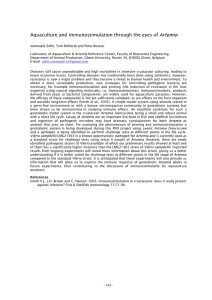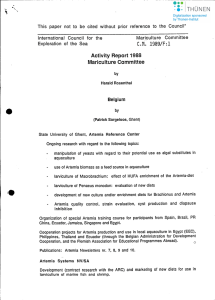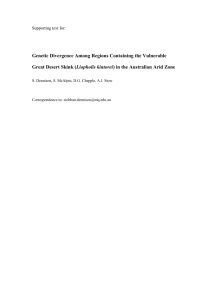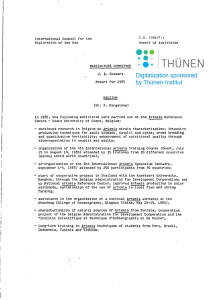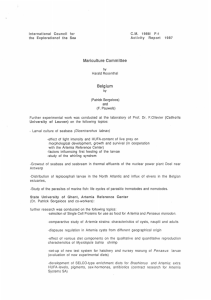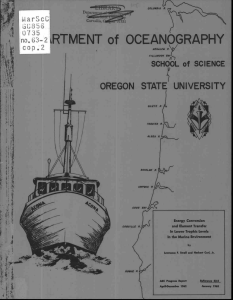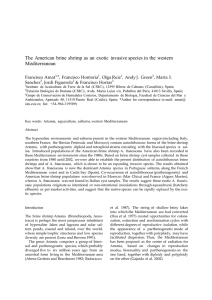molecores09artemia.doc
advertisement
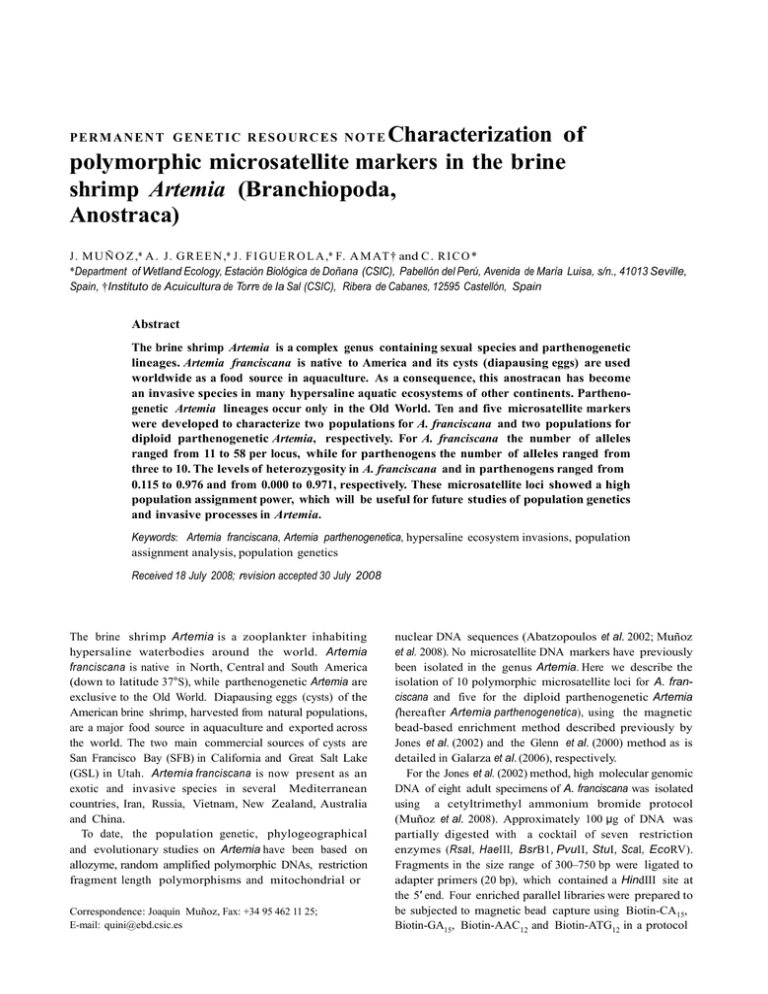
Characterization of polymorphic microsatellite markers in the brine shrimp Artemia (Branchiopoda, Anostraca) PERMANENT GENETIC RESOURCES NOTE J . M U Ñ O Z ,* A . J . G R E E N ,* J . F I G U E R O L A ,* F. A M AT † and C . R I C O * *Department of Wetland Ecology, Estación Biológica de Doñana (CSIC), Pabellón del Perú, Avenida de María Luisa, s/n., 41013 Seville, Spain, †Instituto de Acuicultura de Torre de la Sal (CSIC), Ribera de Cabanes, 12595 Castellón, Spain Abstract The brine shrimp Artemia is a complex genus containing sexual species and parthenogenetic lineages. Artemia franciscana is native to America and its cysts (diapausing eggs) are used worldwide as a food source in aquaculture. As a consequence, this anostracan has become an invasive species in many hypersaline aquatic ecosystems of other continents. Parthenogenetic Artemia lineages occur only in the Old World. Ten and five microsatellite markers were developed to characterize two populations for A. franciscana and two populations for diploid parthenogenetic Artemia, respectively. For A. franciscana the number of alleles ranged from 11 to 58 per locus, while for parthenogens the number of alleles ranged from three to 10. The levels of heterozygosity in A. franciscana and in parthenogens ranged from 0.115 to 0.976 and from 0.000 to 0.971, respectively. These microsatellite loci showed a high population assignment power, which will be useful for future studies of population genetics and invasive processes in Artemia. Keywords: Artemia franciscana, Artemia parthenogenetica, hypersaline ecosystem invasions, population assignment analysis, population genetics Received 18 July 2008; revision accepted 30 July 2008 The brine shrimp Artemia is a zooplankter inhabiting hypersaline waterbodies around the world. Artemia franciscana is native in North, Central and South America (down to latitude 37°S), while parthenogenetic Artemia are exclusive to the Old World. Diapausing eggs (cysts) of the American brine shrimp, harvested from natural populations, are a major food source in aquaculture and exported across the world. The two main commercial sources of cysts are San Francisco Bay (SFB) in California and Great Salt Lake (GSL) in Utah. Artemia franciscana is now present as an exotic and invasive species in several Mediterranean countries, Iran, Russia, Vietnam, New Zealand, Australia and China. To date, the population genetic, phylogeographical and evolutionary studies on Artemia have been based on allozyme, random amplified polymorphic DNAs, restriction fragment length polymorphisms and mitochondrial or Correspondence: Joaquín Muñoz, Fax: +34 95 462 11 25; E-mail: quini@ebd.csic.es nuclear DNA sequences (Abatzopoulos et al. 2002; Muñoz et al. 2008). No microsatellite DNA markers have previously been isolated in the genus Artemia. Here we describe the isolation of 10 polymorphic microsatellite loci for A. franciscana and five for the diploid parthenogenetic Artemia (hereafter Artemia parthenogenetica), using the magnetic bead-based enrichment method described previously by Jones et al. (2002) and the Glenn et al. (2000) method as is detailed in Galarza et al. (2006), respectively. For the Jones et al. (2002) method, high molecular genomic DNA of eight adult specimens of A. franciscana was isolated using a cetyltrimethyl ammonium bromide protocol (Muñoz et al. 2008). Approximately 100 μg of DNA was partially digested with a cocktail of seven restriction enzymes (RsaI, HaeIII, BsrB1, PvuII, StuI, ScaI, EcoRV). Fragments in the size range of 300–750 bp were ligated to adapter primers (20 bp), which contained a HindIII site at the 5′ end. Four enriched parallel libraries were prepared to be subjected to magnetic bead capture using Biotin-CA15, Biotin-GA15, Biotin-AAC12 and Biotin-ATG12 in a protocol provided by the manufacturer (CPG, Inc.). Captured molecules with repetitive sequences were amplified and restricted with HindIII to remove the adapters. The resulting fragments were ligated into the HindIII site of the pUC19 plasmid and introduced into Escherichia coli strain DH5α by electroporation (ElectroMax, Invitrogen). A total of 45 different microsatellite-containing clones were identified in A. franciscana, while 27 were identified in A. parthenogenetica. Only 31 and 19 polymerase chain reaction (PCR) primer pairs, respectively, could be designed using Primer 3 (Rozen & Skaletsky 2000) and oligo version 6.4 (Molecular Biology Insight, Inc.) software. Seventeen and eight of the primer pairs, respectively, yielded products of varying size, within the clonal expected size range, from 10 different brine shrimp samples and were selected for fluorescent labelling. PCR amplifications were carried out in 20-μL total volume containing 2 μL of 10× PCR buffer (Bioline), 1.5–3.0 mm of MgCl2 (Bioline), 0.25–0.60 μm of each primer (see Table 1 for details), 250 μm of each dNTPs, 0.5 μL of 20 mg/mL bovine serum albumin (BSA) (Roche Diagnostics), and 0.5 U Taq DNA polymerase (Bioline). Reaction conditions were as follows: an initial denaturation step at 95 °C for 5 min, 16–21 cycles consisting of 60 s at 95 °C, 60 s at 60 °C decreasing 1 °C per cycle, and 60 s at 72 °C. Then, 24 additional cycles were performed consisting of a step of 30 s at 95 °C, 30 s at 40 °C, and 30 s at 72 °C, and a final supplementary extension step of 15 min at 72 °C. Ten out of the 17 polymorphic markers were screened in a set of 88 individual cysts from two US populations [GSL (n = 42), and SFB (n = 46)] in A. franciscana. Five out of the eight loci for A. parthenogenetica were screened in a set of 50 individual cysts from two Spanish populations [Cabo de Gata, GAT (n = 15), and La Mata, MAT (n = 35)]. DNA was isolated from individual cysts using the MonteroPau et al. protocol (2008). Individuals were genotyped by assessing allele size on an ABI 3130xl Genetic Analyser (Applied Biosystems) using forward primers labelled with FAM (Sigma), and NED, PET and VIC (Applied Biosystems) together with LIZ 500 size standard (Applied Biosystems). Due to some screened loci showing peaks with one base of difference, we added a palindromic sequence (5′-GTGTCTT-3′) at the 5′ end of their unlabelled reverse primer (see Table 1) in order to minimize the generation of stutter peaks (Brownstein et al. 1996). Allele scoring was carried out in two independent laboratories using GeneMapper version 3.7 software (Applied Biosystems). Sequences of loci were deposited in GenBank (EU888832– EU888846). Observed and expected heterozygosities, deviations from Hardy–Weinberg equilibrium (HWE) expectations and linkage disequilibrium were calculated using Arlequin version 2.000 (Schneider et al. 2000). Sequential Bonferroni corrections for multiple tests were applied using a global P value of 0.05 (Rice 1989). The program Micro-Checker version 2.2.3 ( van Oosterhout et al. 2004) was used to test for null alleles, large allele dropout and scoring errors due to stutter peaks. The number of alleles detected at each locus ranged from 11 to 58 for A. franciscana, and from three to 10 for A. parthenogenetica, identifying frequent single-base alleles. Observed heterozygosity ranged from 0.115 to 0.976 for A. franciscana and from 0.000 to 0.971 for A. parthenogenetica showing in some loci excess of heterozygosity probably due to its reproduction mode (see Table 1). Six and four loci showed significant departures from HWE expectations after Bonferroni corrections in A. franciscana from SFB and GSL, respectively. Only two loci showed departures from HWE in both populations (Af_B139TAIL and Af_B105TAIL). One and two loci showed significant departures from HWE in A. parthenogenetica from GAT and MAT, respectively. Analyses performed with Micro-Checker indicated homozygote excess at loci with HWE departures was due to the presence of null alleles. Although two independent laboratories assigned identical genotypes, Micro-Checker identified scoring error in locus Af_A108 at A. franciscana from SFB population due to shortage of heterozygote genotypes in alleles of one repeat unit difference. For A. franciscana, there was significant linkage disequilibrium for two loci in SFB (Af_B9, Af_A136), two loci in GSL (Af_B117TAIL, Af_B139TAIL), and one locus in both populations (Af_B105TAIL) (see Table 1 for details), while no significant linkage disequilibrium was found in the parthenogens. Additionally, no evidence for large allele dropout was observed. Finally, population assignment analysis (PAA) and principal coordinates analysis (PCA) (see Fig. S1) were assessed with genalex version 6 (Peakall & Smouse 2006) using the 10 loci described in Table 1, showing a high discriminatory power between populations, and 100% of assignment capacity in the A. franciscana specimens analysed. The same assignment capacity was observed for A. parthenogenetica populations (figure not shown). Although some loci need to be used with care given the presence of null alleles, these new microsatellite markers will provide useful tools to assess genetic variation and genetic structure in the populations of these two Artemia, and should be useful to identify the source of introduction events in the Mediterranean Basin and elsewhere. Thus, these results could assist in future conservation plans. Acknowledgements We are indebted to Juan Miguel Arroyo for assistance with genotyping. We thank Catalina Monzón for assistance and discussion of analyses. Africa Gómez, Cino Pertoldi and Jacob Gratten provided constructive criticism of an earlier version of this manuscript. This work was funded by the Spanish Ministerio de Educación y Ciencia (projects BOS2003-02486 and CGL 2006-05085 BOS). © 2008 The Authors Journal compilation © 2008 Blackwell Publishing Ltd © 2008 The Authors Journal compilation © 2008 Blackwell Publishing Ltd Table 1 Characterization of polymorphic microsatellite marker isolates for Artemia showing name of locus with fluorescent labels used in primer sequences. Locus and GB Acc. No. Artemia franciscana Af_A108 San Francisco Bay population MgCl2 N Size range HO HE P FNA Linked loci (mm) A (bp) Great Salt Lake population Primer sequences (5′–3′) Repeat sequence Ta F: FAM-AGTGGCACAACATCCTTTTG (CA)13 60–40 3.0 12 150–177 0.357 0.804 < 0.001* 0.268 0.704 0.724 0.186 (TC)25 60–40 3.0 25 154–207 0.800 0.796 0.785 (CT)18 60–40 3.0 11 212–236 0.357 0.355 0.224 0.341 0.917 < 0.001* 0.306 B105TAIL/ B139TAIL 0.822 0.819 0.635 (CA)16 60–40 3.0 19 97–144 0.115 0.685 < 0.001* 0.384 0.683 0.879 (GA)30 60–40 2.0 58 238–390 0.167 0.900 < 0.001* 0.395 (GA)23 60–40 2.0 24 236–281 (GA)14 AA(GA)5 (GA)16 GG(GA)13 (CT)17 60–40 2.0 39 194–288 0.579 0.926 < 0.001* 0.182 B105TAIL /A136 0.976 0.949 0.967 0.786 0.984 < 0.001* 0.096 B109/ B117TAIL/B9 0.850 0.905 0.170 60–40 3.0 31 266–314 0.536 0.950 < 0.001* 0.210 A136/B9 60–40 3.0 37 286–338 0.909 0.935 (TG)10 60–40 3.0 19 215–317 0.189 0.814 < 0.001* 0.363 B105TAIL/B9 0.738 0.790 0.513 (TG)19 60–45 1.5 3 175–183 Mon. Mon. — 0.014 (ACT)20 60–45 2.0 4 229–250 0.200 0.494 0.004* 0.239 Mon. Mon. — (GA)11 60–45 2.0 5 212–238 0.933 0.651 0.122 0.057 0.057 (AG)21 60–45 1.5 4 308–318 0.400 0.515 0.020 0.000 0.111 < 0.001* 0.210 (AG)35 60–45 2.0 10 85–181 0.800 0.660 0.700 0.971 0.668 < 0.001* –0.319 0.906 HE P 0.953 0.973 FNA Linked loci 0.019 0.518 0.179 0.913 < 0.001* 0.394 B117TAIL/ A104TAIL 0.868 0.945 0.133 0.000 0.056 1.000 Notes: GB Acc. no., GenBank Accession no.; Ta, annealing temperature (see text for details); NA, number of alleles for each locus; HO, observed heterozygosity; HE, expected heterozygosity under Hardy–Weinberg equilibrium; P, P value of exact test using Markov chains with a confidence interval of 95%. FNA, frequency of null alleles based on the Oosterhout method (Micro-Checker software); Mon., monomorphic locus. Asterisks indicate significant departure from Hardy–Weinberg equilibrium after Bonferroni correction. P E R M A N E N T G E N E T I C R E S O U R C E S N O T E 549 EU888840 R: AACCACGCATGTGTTTTCAT Af_B117TAIL F: VIC-CGTACCTTCAAGAGCTTTAGTC EU888834 R: GTGTCTTGCTGATATTGTTTGCTTGTTC Af_B10 F: VIC-CTTTGCCTGGATCTCTAACAAA EU888838 R: AGGAGGGTAAAGGGTAAAAAGG Af_A104TAIL F: PET-ATGCACACACGTTCACACTC EU888841 R: GTGTCTTGGCCTATTGTAGCAAAGTGG Af_B139TAIL F: PET-GAAGGAAAGGAAGAAGGATTAG EU888833 R: GTGTCTTAGAGCAAAGCCAAACTCAT Af_B9 F: VIC-ACCTCCAAACACACAAAGTTG EU888832 R: CCCGTTTCTCTCTCTCTCTATG Af_B109 F: PET-CACTCGCTAGGTTCAGAGTAAC EU888836 R: ACCCTTATCTGGTGGTAAAGTC Af_B105TAIL F: NED-GGCAGATCAGTTTGACAGGAC EU888837 R: GTGTCTTAGATTACGCCAACGGTTGTAG Af_B11 F: PET-GGGGAATTAAGTGGATTG EU888835 R: TCCCTAGTTCAACATACCAC Af_A136 F: PET-TCTGGAAACCCTGATTAGACG EU888839 R: CGTCACTCGACACACAAACAT Artemia parthenogenetica Apdq01TAIL F: FAM-ATTGGCCAGCTCTTCTGTTG EU888844 R: GTGTCTTGCATCCGATTTTGTTCCTGT Apdq02TAIL F: VIC-ACGCTGACTTTTGGTTGATC EU888845 R: GTGTCTTCCTGGAAGGGTGTAAAGAGT Apdq03TAIL F: NED-CACGAAAACAAGCCGTGATAG EU888842 R: GTGTCTTTCTCTCTCTGCCTTTCTGTCC Apdq04TAIL F: VIC-GGACATTTTCGTTTCCAGTG EU888843 R: GTGTCTTTCTGCAGCGTTGGACTATTG Apdq05TAIL F: PET-CAGAGTAAATCGACCATGTG EU888846 R: GTGTCTTAGAGCAAATCTCTCCTCTCC HO References Abatzopoulos TJ, Berardmore JA, Clegg JS, Sorgeloos P (2002) Artemia. Basic and Applied Biology. Kluwer Academic Publishers, Dordrecht, The Netherlands. ISBN: 1-4020-0746-9, 286 pages. Brownstein MJ, Carpten JD, Smith JR (1996) Modulation of non-templated nucleotide addition by Taq DNA polymerase: primer modifications that facilitate genotyping. BioTechniques, 20 (6), 1004 –1010. Galarza JA, Carreras-Carbonell J, MacPherson E, Turner GF, Rico C (2006) Isolation and characterization of polymorphic microsatellite markers for peacock wrasse (Symphodus tinca). Molecular Ecology Notes, 6, 747–749. Glenn TC, Cary T, Dust M et al. (2000) Microsatellite Isolation. Available from URL: http://www.uga.edu/srel/DNA_Laboratory/ protocols.htm. Jones KC, Levine KF, Banks JD (2002) Characterization of 11 polymorphic tetranucleotide microsatellites for forensic applications in California elk (Cervus elaphus canadensis). Molecular Ecology Notes, 2, 4 2 5 – 427. Montero-Pau J, Gómez A, Muñoz J (2008) Application of an inexpensive and high-throughput genomic DNA extraction method for the molecular ecology of zooplanktonic diapausing eggs. Limnology and Oceanography: Methods, 6, 218 –222. Muñoz J, Gómez A, Green AJ et al. (2008) Phylogeography and local endemism of the native Mediterranean brine shrimp Artemia salina (Branchiopoda: Anostraca). Molecular Ecology, 17, 3160 –3177. van Oosterhout C, Hutchinson WF, Wills DPM, Shipley P (2004) Micro-Checker: software for identifying and correcting genotyping errors in microsatellite data. Molecular Ecology Notes, 4, 535 –538. Peakall R, Smouse PE (2006) genalex 6: genetic analysis in Excel. Population genetic software for teaching and research. Molecular Ecology Notes, 6, 288 –295. Rice WR (1989) Analyzing tables of statistical tests. Evolution, 43, 223 –225. Rozen S, Skaletsky HJ (2000) Primer 3 on the WWW for general users and for biologist programmers. In: Bioinformatics Methods and Protocols: Methods in Molecular Biology (eds Krawetz S, Misener S), pp. 365–386. Humana Press, Totowa, New Jersey. Schneider S, Roessli D, Excoffier L (2000) Arlequin, Version 2.000: A Software for Population Genetics Data Analysis. Genetics and Biometry Laboratory, University of Geneva, Switzerland. Supporting Information Additional supporting information may be found in the online version of this article. Fig. S1 Plot of principal coordinates analysis (PCA) performed with genalex software using the 10 polymorphic microsatellite loci described for Artemia franciscana in Table 1. Black squares and white triangles indicate individuals from the San Francisco Bay and Great Salt Lake populations, respectively. Please note: Wiley-Blackwell are not responsible for the content or functionality of any supporting information supplied by the authors. Any queries (other than missing material) should be directed to the Molecular Ecology Resources Central Office. © 2008 The Authors Journal compilation © 2008 Blackwell Publishing Ltd Coordinate 2 (8.36%) Figure 1 Coordinate 1 (16.67%)
